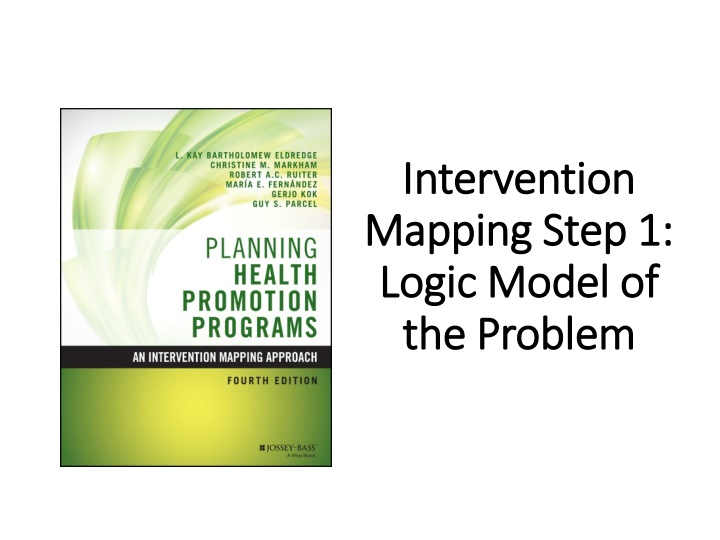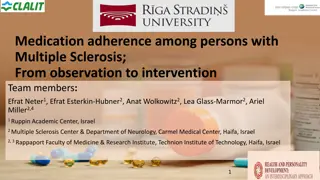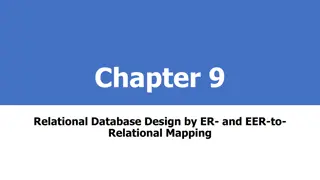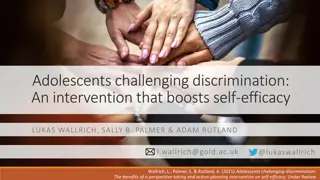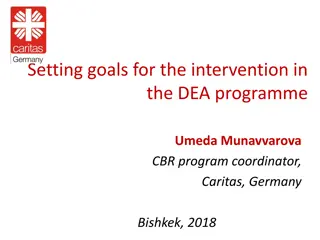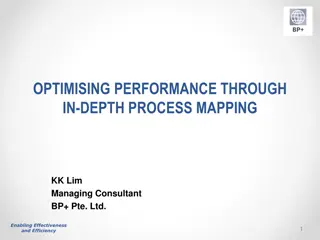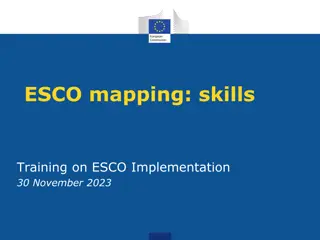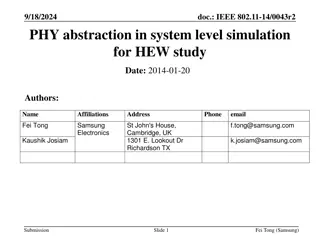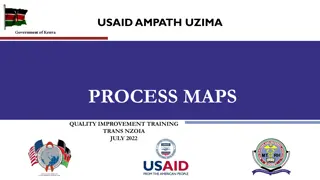Intervention Mapping Process for Effective Program Development
The intervention mapping process involves several key steps including logic model creation, needs assessment tasks, establishing a planning group, conducting a needs assessment, and utilizing primary and secondary data sources to inform program design and implementation. This method ensures programs are well-designed, targeted, and have a higher likelihood of success by addressing community concerns and utilizing evidence-based approaches.
Download Presentation

Please find below an Image/Link to download the presentation.
The content on the website is provided AS IS for your information and personal use only. It may not be sold, licensed, or shared on other websites without obtaining consent from the author.If you encounter any issues during the download, it is possible that the publisher has removed the file from their server.
You are allowed to download the files provided on this website for personal or commercial use, subject to the condition that they are used lawfully. All files are the property of their respective owners.
The content on the website is provided AS IS for your information and personal use only. It may not be sold, licensed, or shared on other websites without obtaining consent from the author.
E N D
Presentation Transcript
Intervention Intervention Mapping Step 1: Mapping Step 1: Logic Model of Logic Model of the Problem the Problem
Intervention Mapping Steps 1. Logic model of the problem 2. Program outcomes and objectives (logic model of change) 3. Program design 4. Program production 5. Program implementation plan 6. Evaluation plan 2
Step 1: Needs Assessment Tasks 1. Establish and work with a planning group 2. Conduct a needs assessment to create a logic model of the problem 3. Describe the intervention context, including the population, setting, and community 4. State program goals 3
Task 1: Establish and Work with a Planning Group Equitable community participation Ensures program focus reflects community concerns Brings greater breadth of skills, knowledge & expertise Improves external validity 4
Task 2: Conduct a Needs Assessment Develop a logic model of the factors that cause or influence the health problem that will be the focus of the intervention Use the PRECEDE model to obtain an epidemiologic, behavioral, and social perspective of a community or population at risk for health-related problems 5
Logic Model of the Problem INSERT Figure 1.2 HERE Figure 1.2 6
Primary Data Sources Data collection from individuals or groups Key informant interview Survey (mail, in- person, telephone, internet) Critical incident technique (as part of a survey or interview) Ethnographic interview and observation Interacting Community forum Focus groups Nominal group technique Natural groups and planning groups Photovoice Non-interacting Mailed Delphi survey
Secondary Data Sources Behavioral surveillance surveys (YRBS, BRFS, NHANES) Fertilty & Mortality data (National Vital Statistics System, NSFG) Disease registries Health services utilization (NIS, National Hospital Discharge Survey) Medicare & Medicaid data US Census State, county, city health departments Other sources (foundations, non- profits)
Describing the Priority Population A group with a definable boundary and shared characteristics that: Is at risk for certain health and quality-of- life problems, or Has health problems and are at risk for the sequelae
Describing Health Problems and Quality of Life The basic questions for this process are: What is the problem? Who has it? What are the incidence, prevalence, and distribution of the problem? Is there a community? What are its characteristics including its resources and strengths? What segments of the population have an excess burden from the health problem? Where can the groups at risk, especially groups at excess risk or excess burden, be reached by a program?
Describing Health Problems Assess the extent and distribution of a problem in a population Vital Indicators: disability, discomfort, fertility, fitness, morbidity, mortality, physiological risk factors Dimensions: distribution, duration, functional level, incidence & prevalence, intensity, longevity
Quality of Life From an individual or societal perspective Example indicators: Absenteeism, loss of productivity, achievement, aesthetics, discrimination, happiness, medical costs, social isolation, stigma, taxes, unemployment, welfare
Describing Behavior of the Priority Population Identify health-related behavioral factors that could be causally linked to the health problem(s) Example indicators: Low adherence, over/under consumption, poor coping, lack of preventive action, risk behavior, under-utilization, low self-care
Describing Environmental Risk INSERT Figure 1.2 HERE Figure 1.2
Identifying Environmental Conditions Social or physical conditions that influence risk behavior - indirectly or directly causes health problem Social Environment: behavior of parents, peers, employers, health care providers; access to services; rules or laws; availability of resources Physical Environment: water, air, housing Environmental factors can be prioritized in terms of their importance and changeability
Examples of Interpersonal Environment Families - primary influence for socialization of children and continue to effect behavior throughout life Peer groups - friends, neighbors, coworkers, and members of organizations (e.g., churches, social clubs, and service groups) Influential roles - special influence e.g., teachers, coaches, religious leaders, health care providers
Examples of Organizational Environment Elements such as policies, practices, norms, and facilities Examples of health-related organizational elements: Health care policies and health care facility characteristics e.g., hours of operation, lack of bilingual staff, long wait times, not accessible via public transportation Policies requiring parental consent
Examples of Community Environment Quality and quantity of housing Access to health care Availability of recreational resources Smoking and other health ordinances Law enforcement, judicial practices Treatment resources for social problems e.g., child abuse, violence, and drug addiction
Examples of Societal Environment Legislation Enforcement Regulation Resource allocation Policies, programs, and facilities of large political and geographic groups Societal influences often function through governments
Describing Determinants of Behavioral and Environmental Risk INSERT Figure 1.2 HERE Figure 1.2
Describing Determinants Determinants of the behavior and environmental factors Reside at the individual level (predisposing, reinforcing, and enabling factors) (e.g., attitudes, knowledge, self-efficacy, cultural beliefs) Evidence for determinants is usually correlational vs. causal, so determinants are somewhat hypothetical
Task 3: Describe the Intervention Context It is important to balance the needs assessment with an assessment of the community s assets, capacities, and abilities Map assets and capacities at each environmental level to identify existing community factors that could be incorporated or leveraged to support a health promotion program Identify an appropriate setting for the intervention with widespread access to the priority population and the capacity to implement the intervention with fidelity 22
Community Asset Assessment INSERT Table 4.4 HERE Table 4.4 23
Task 4: State Program Goals Set priorities Write program goals Health outcomes Health-related behavioral outcomes Health-related environmental outcomes 24
Criteria for Setting Priorities Magnitude between what is & what could be Difference in burden from a problem among groups Practical issues, e.g., consequences of ignoring the needs vs. possible costs of implementing a solution Political and social factors, e.g., community values, context of priorities (local, regional, national and international), public and leader expectations, available interest and expertise, momentum, and availability of funding and human resources (Altschuld & Kumar, 2010)
Relevance and Changeability Relevance = evidence of strength of association E.g., between behavior & health outcome, environmental factor & behavior, determinant & behavior Use evidence tables to summarize findings Consider effect sizes not just statistical significance Changeability = strength of the evidence that the behavior (environmental factor or determinant) can be changed by an intervention Behaviors and environmental factors that are both more relevant and more changeable will be a high priority for program focus
Program Goals From the Needs Assessment Type of Objective Health Outcomes Definition What will change in terms of the health problem? Among whom? By how much? By when? Health-Related Behavior Outcomes What health related behavior will change? Among whom? By how much? By when? What environmental conditions will change? By how much? By when? Health-related Environmental Outcomes
Example It s Your Game Keep It Real (IYG) A sexual health education program for middle school students 28
Task 1: Establish and Work with a Planning Group Planning group: Health educators, behavioral scientists, epidemiologists, a pediatrician, and an expert in human sexuality (program developers) School district personnel, principals, school nurse, parents, community agency representatives , pediatricians, sexuality experts (potential implementers and dissemination partners) Parents (end users) Teen Advisory Group (ages 12-15 years) 29
Task 2: Conduct a Needs Assessment Questions What is the prevalence of teen pregnancy, STIs, and HIV infection? What behavioral and environmental factors are associated with increased risk of teen pregnancy, STIs, and HIV infection? Data sources Surveillance data Literature review (theory & empirical studies) Community input Key informant interviews Focus groups (youth and parents) Surveys Observation 30
IYG Logic Model of the Problem INSERT Figure 4.4 HERE Figure 4.4 31
Task 3: Describe the Intervention Context Most adolescents in the US spend six to seven hours a day at school logical setting for intervention Focus group data indicated that most parents wanted middle schoolers to receive sexual health education Meetings with school district personnel indicated that the school district was supportive of effective pregnancy, HIV and STI prevention programs School district was willing to provide class time 32
Task 4: State Program Goals Evaluation time frame insufficient to assess the intervention s effect on these health outcomes Focused on program goals for health behavior After two years of the intervention, the percentage of students in the intervention group who have not initiated sexual intercourse by ninth grade will be 10 percent higher compared to students in the nonintervention group After two years of the intervention, the percentage of sexually active students in the intervention group who used a condom at last sexual intercourse will be 10 percent higher compared to students in the nonintervention group 33
Summary IM Step 1 comprises 4 key tasks: 1. Establish and work with a planning group 2. Conduct a needs assessment to create a logic model of the problem 3. Describe the intervention context, including the population, setting, and community 4. State program goals
